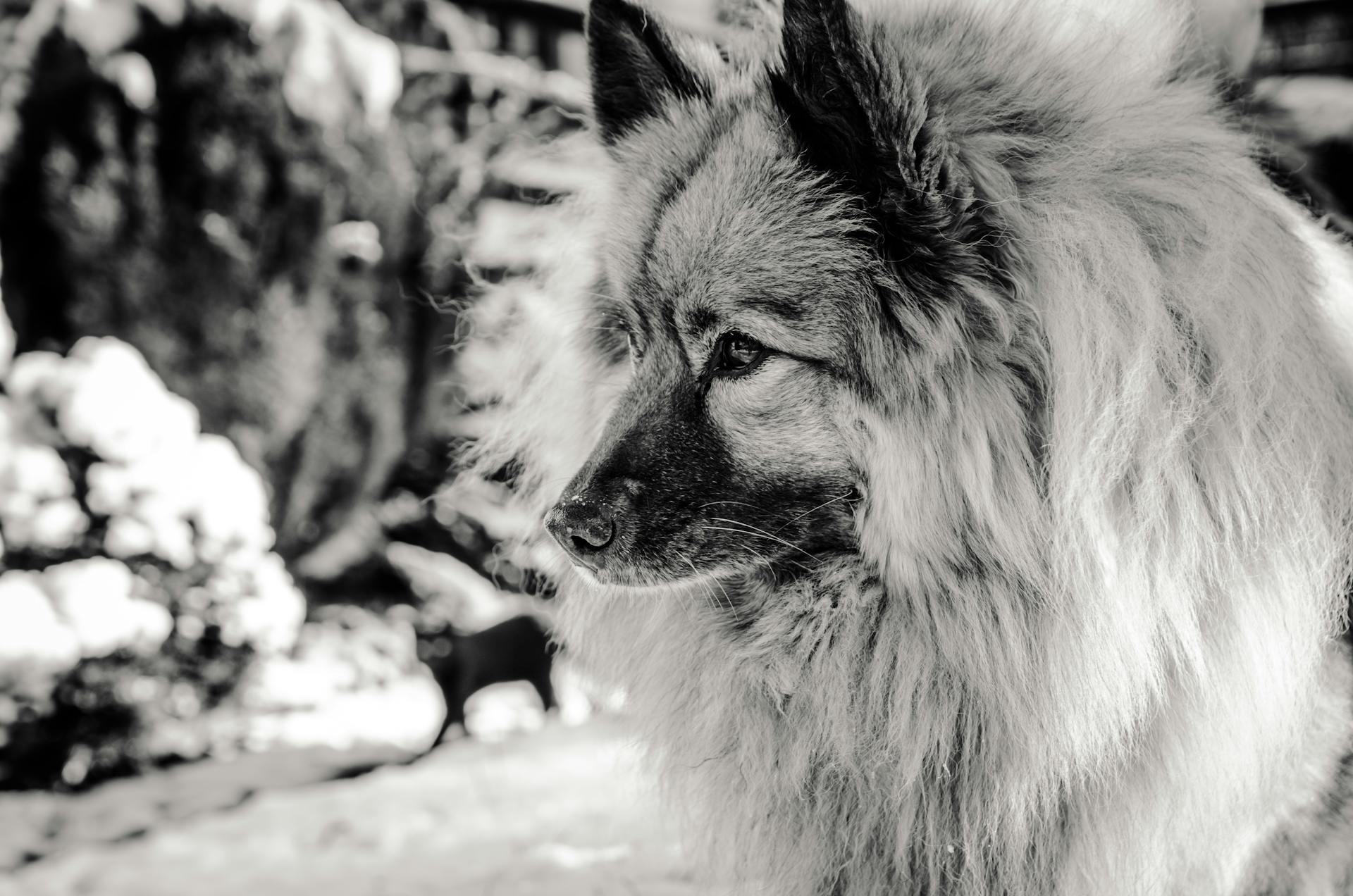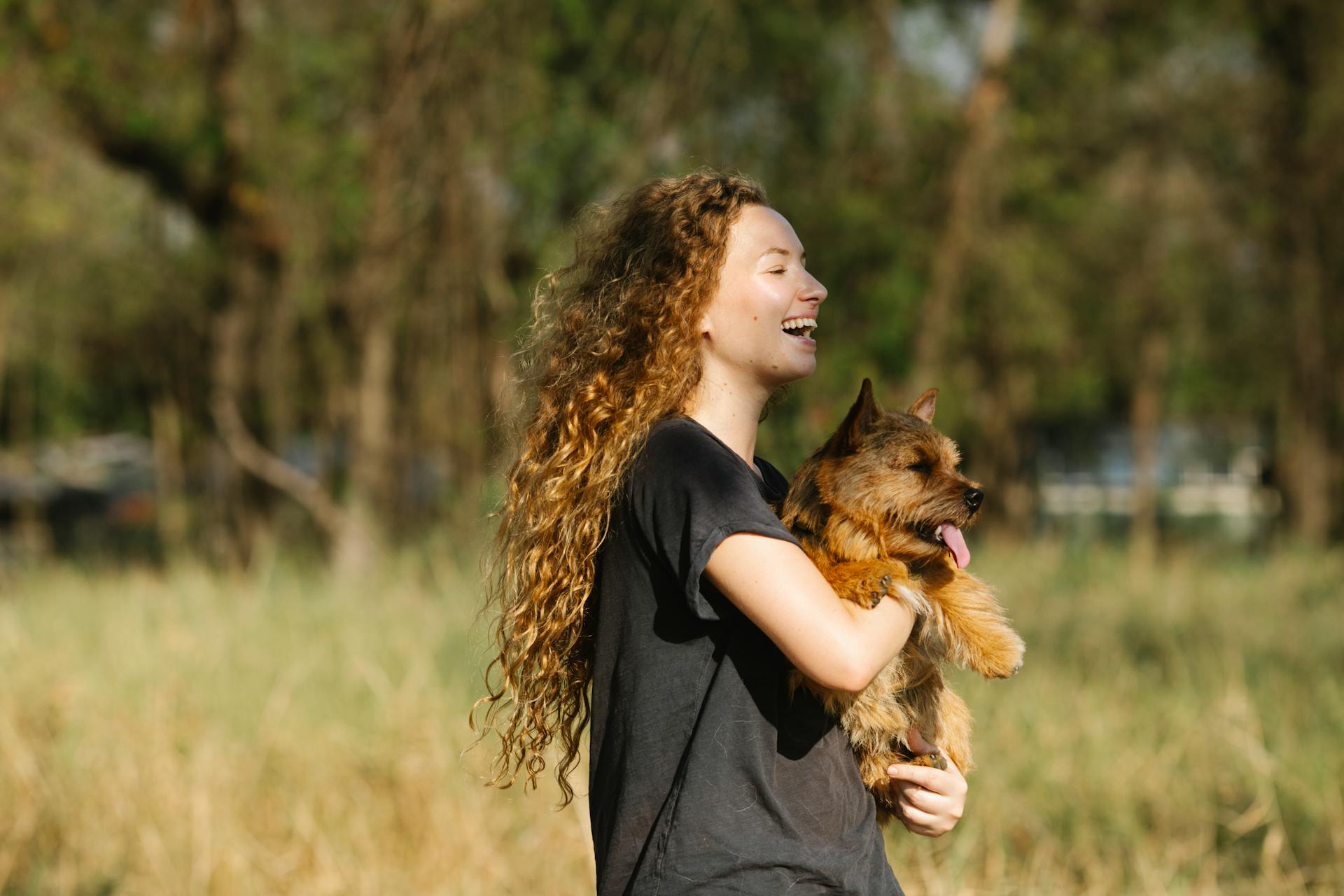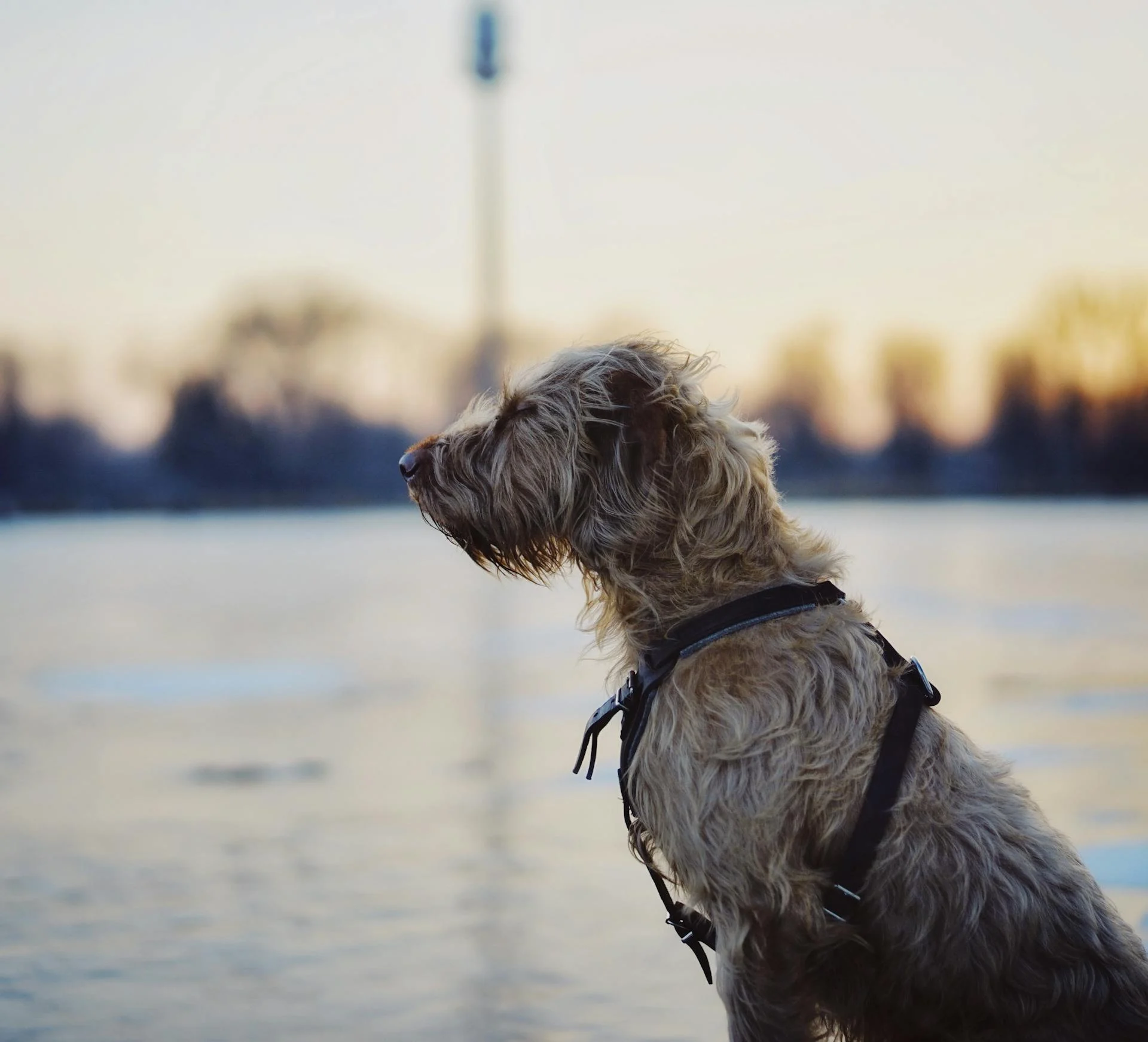
Irish Wolfhounds are a unique breed that requires special care and attention. They can live up to 7-10 years, but their lifespan is shorter than other breeds due to their large size and potential health issues.
Their size can be intimidating, but they are gentle giants. Adult Irish Wolfhounds can weigh between 105-120 pounds and stand as tall as 35 inches at the shoulder.
With their calm and gentle nature, they make great family pets. However, they do require regular exercise to stay happy and healthy, and a large living space is a must.
Irish Wolfhounds are intelligent and trainable, but they can be stubborn at times. Consistent training and positive reinforcement are key to developing good behavior.
Check this out: Large Münsterländer
History and Origins
The Irish wolfhound is an ancient breed with a rich history that spans centuries. The breed's origins date back to 391 AD, when Roman statesman Quintus Aurelius Symmachus received several large Irish hounds as a gift.
These early Irish hounds were bred with Middle Eastern hounds, resulting in a majestic and powerful breed. Over time, they became known for their ability to hunt big game, including elk and wolves.
The Irish wolfhound's reputation as a fearsome warrior and talented big-game hunter was cemented over the centuries. They were large enough to bring down elk and quick enough to pursue smaller game.
In Ireland, the breed had become a status symbol, with large Irish wolfhounds being given as gifts between rulers and nobles. This practice contributed to the breed's decline in numbers.
The Irish wolfhound nearly disappeared after the elk and wolves in Ireland were hunted to extinction. However, thanks to the efforts of Captain George Augustus Graham, a British army captain, the breed was revived in the mid-1800s.
Captain Graham acquired several of the few remaining wolfhounds in Ireland and established a breeding program, introducing Scottish deerhound and Great Dane bloodlines to the breed. The American Kennel Club first recognized the Irish wolfhound in 1897.
Expand your knowledge: Game Bred American Pit Bull Terrier
Care and Health
As an adult Irish Wolfhound owner, you're probably aware that this breed is prone to certain health issues. Hip and elbow dysplasia are common problems that can cause your dog a lot of pain.
Regular exercise is crucial to prevent obesity, which can strain their joints and lead to health problems. A daily walk or run is sufficient, although they will also enjoy playing fetch or going for a swim.
Irish Wolfhounds are also at risk for heart disease, with an estimated 30% developing some form of it by the age of six. This is why regular veterinary checkups are essential.
Bloat, also known as gastric dilatation-volvulus, is a potentially life-threatening condition that can occur when the stomach twists. To prevent this, feed your Irish Wolfhound at least two meals per day.
To keep your Irish Wolfhound's coat healthy and free of tangles, regular grooming is necessary. Brush them at least once a week, although daily brushing is best during periods of heavy shedding.
Check this out: Rhodesian Ridgeback Behavior Problems
Here are some common health concerns to be aware of:
- Bloat (gastric dilatation-volvulus)
- Heart disease
- Joint dysplasia (hip and elbow)
- Eye problems (progressive retinal atrophy, cataracts, corneal dystrophy)
- Cancer (osteosarcoma)
Irish Wolfhounds are also prone to autoimmune thyroiditis, which affects the thyroid gland. Regular veterinary checkups can help detect this condition early on.
To prevent tartar buildup and keep your Irish Wolfhound's gums healthy, brush their teeth at least once a week.
Diet and Nutrition
To keep your adult Irish Wolfhound healthy, it's essential to provide a balanced diet that meets their nutritional needs. Always have fresh water available.
Choose a dog food specifically formulated for large breeds to ensure you're meeting your dog's nutritional requirements. Discuss the variety and amount with your vet, as this can vary based on age, activity level, and other factors.
Feeding two measured meals per day is a common approach, but you should be mindful of treats and extra food to prevent your dog from becoming overweight.
Irish Wolfhounds are at risk of bloat and potentially life-threatening stomach twists, which can arise when a dog eats too quickly. Using puzzle toys that slowly dispense food can help to prevent bloat.
As a general rule, it's best to feed your Irish Wolfhound high-quality food that's high in protein and fat to maintain lean muscle mass.
Exercise and Stimulation

Adult Irish wolfhounds need at least an hour of exercise each day to stay happy and healthy.
They can make excellent jogging or running partners, but only once their skeletal system is fully developed. This usually happens as they mature.
Providing daily access to plenty of space is crucial for this large breed. A fenced yard where they can run and move freely is ideal.
However, it's essential to keep in mind that Irish wolfhounds are sighthounds with a strong prey drive. This means they can suddenly take off after a squirrel, so it's best to let them run free in an enclosed space.
With proper exercise, Irish wolfhounds are usually quite docile in the house. Some owners even have to coax them to exercise each day, as they can be quite the couch potato.
Mental stimulation is just as important as physical exercise for Irish wolfhounds. They were bred to hunt by sight and chase, so they need to exercise their brains as well as their bodies.
Irish wolfhounds excel in dog sports like agility and tracking, and they also perform well in lure coursing, an endurance sport that requires them to react to unpredictable movement.
For another approach, see: Rhodesian Ridgeback Speed
Grooming
Grooming is an essential part of caring for your adult Irish wolfhound.
Brushing your Irish wolfhound's coat is a must, with a recommended frequency of at least weekly to remove loose fur and debris.
Irish wolfhounds have a wiry texture to their coat, which gives them a shaggy appearance.
To keep their coat in good condition, you should aim to brush them around twice a week.
However, if your Irish wolfhound gets into something smelly, they may need a bath - and possibly some professional help to get them clean.
Bathing your Irish wolfhound should be done every one to two months, depending on how dirty they get.
Don't forget to check your Irish wolfhound's ears at least weekly for dirt, irritation, and other abnormalities.
And, to keep their nails in check, aim to trim them roughly once a month.
Daily toothbrushing is also crucial to keep your Irish wolfhound's teeth healthy, complemented by annual dental exams and occasional professional cleanings.
Cost and Ownership

If you're considering bringing an adult Irish Wolfhound into your life, you should be prepared for the financial commitment that comes with owning one.
Irish Wolfhounds from reputable breeders can cost between $1,400 and $2,500, depending on the dog's bloodline and quality.
You'll also need to factor in regular veterinary checkups to ensure your Irish Wolfhound stays healthy, especially since they're prone to various health conditions.
Their large size means they need to eat more than smaller breeds, which can add to their overall cost.
Here are some estimated monthly costs to consider:
- Food: $50-$75 per month
- Veterinary care: $50-$100 per month
- Total: $100-$175 per month
Keep in mind that these are just estimates, and your actual costs may vary depending on your Irish Wolfhound's individual needs.
Irish Wolfhounds are relatively quiet and calm, making them a great choice for families or individuals who want a gentle companion.
General Information
The adult Irish Wolfhound is a majestic breed. They typically live between 6 to 10 years.
These gentle giants can weigh between 105 to 180 pounds, with males being larger than females. With their short coats, they require minimal grooming.
As a relatively healthy breed, they are prone to certain health issues, such as hip dysplasia and bloat.
What Is an Irish Wolfhound?
The Irish Wolfhound is a breed of dog that originated in Ireland, with a history dating back to the 5th century. They were bred to hunt large game such as wolves, elk, and deer.
These dogs are known for their incredible height, with males reaching up to 35 inches tall at the shoulder. They are also known for their short coats, which come in a variety of colors including gray, brindle, red, and black.
Irish Wolfhounds are a relatively rare breed, with a lifespan of around 6-8 years. They are prone to certain health issues, including hip dysplasia and bloat.
Despite their size, Irish Wolfhounds are known for their gentle and friendly nature, making them a great companion for families.
Basic Breed Facts
The Irish wolfhound is a massive breed, with adults averaging 30 to 32 inches in height and weighing up to 180 pounds.
They're also incredibly agile and can reach great speeds despite their size.
Irish wolfhounds are often referred to as gentle giants, a fitting description given their calm demeanor.
However, they don't make ideal guard dogs due to their lack of barking.
The breed's distinctive shaggy coat can be gray, black, white, brindle, red, or fawn, and is made up of a harsh outer coat and a soft undercoat.
They're moderate year-round shedders, requiring weekly brushing to stay looking their best.
Health and Wellness
Irish wolfhounds are a large breed and are prone to several health issues, including hip and elbow dysplasia, osteosarcoma, cardiomyopathy, and gastric torsion. Regular veterinary checkups are essential to catch these issues early.
The best way to ensure your Irish wolfhound stays healthy is to buy them from a reputable breeder who can provide you with health clearances for their parents. A daily walk or run is sufficient exercise for your Irish wolfhound, and they will also enjoy playing fetch or going for a swim.
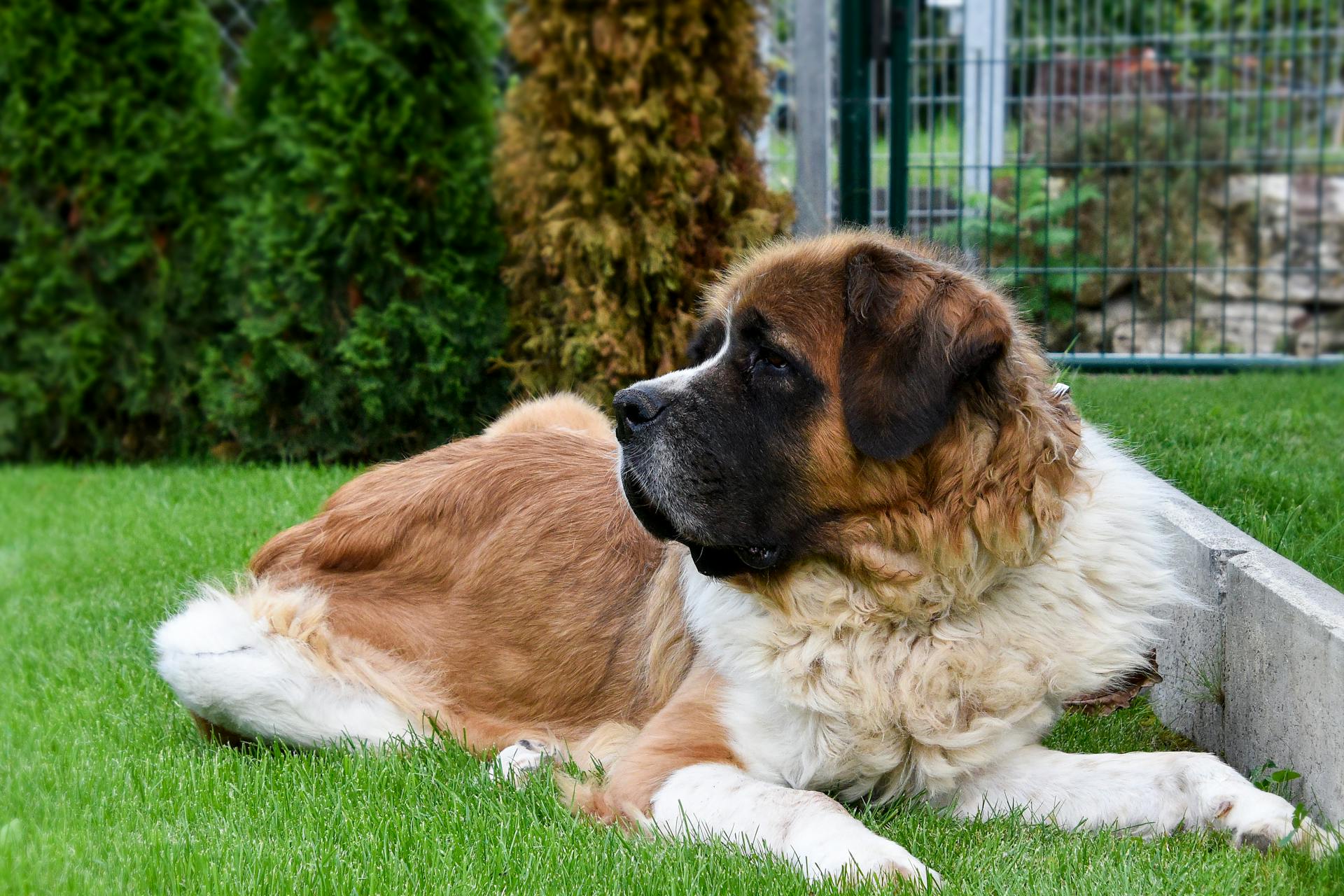
Irish wolfhounds have a lengthy coat that may cause shedding, so regular grooming is necessary to keep their coat healthy and free of tangles. You should brush them at least once a week, although daily brushing is best during periods of heavy shedding.
Some common health problems in Irish wolfhounds include bloat, heart disease, cancer, liver shunt, pneumonia, and eye issues. Bloat, also known as gastric dilatation-volvulus (GDV), is a potentially fatal condition that occurs when the stomach twists as a result of excess food, gas, or fluid.
To help prevent bloat, feed your Irish wolfhound at least two meals per day. You should also check your Irish wolfhound's eyes, ears, and teeth on a daily basis and brush their teeth at least once a week to prevent tartar buildup and keep their gums healthy.
Large breeds like the Irish wolfhound are at a higher risk for joint problems like dysplasia, which occurs when the joint repeatedly dislocates, eventually causing it to degrade. This can be painful and lead to early arthritis.
Here is a list of common health issues in Irish wolfhounds:
- Hip and elbow dysplasia
- Osteosarcoma
- Cardiomyopathy
- Gastric torsion
- Bloat (gastric dilatation-volvulus)
- Heart disease
- Cancer
- Liver shunt
- Pneumonia
- Eye issues (including progressive retinal atrophy and retinal dysplasia)
Regular veterinary checkups and a healthy diet can play a protective role in your Irish wolfhound's long-term health.
Size and Height
The Irish wolfhound is an impressive dog, and one of its most striking features is its size. They are the tallest breed of dog in the world, with an average height of 30-35 inches.
As an adult, an Irish wolfhound can reach incredible heights - an adult male standing upright on its back legs could reach an incredible 7 foot tall! They are truly a sight to behold.
Irish wolfhounds come in a range of sizes, with males typically bigger than females. Males can reach an average size of 34 to 35 inches and 140 to 180 pounds, while females are generally smaller, with a range of 32 to 34 inches and 115 to 140 pounds.
Despite their significant size, Irish wolfhounds are agile and capable of great speed, making them a joy to watch in action.
Take a look at this: Shiba Inu One Cent
Tips and Advice
If you're considering bringing an adult Irish Wolfhound into your home, be prepared for a big appetite - they can eat up to 6-8 cups of food per day.
Irish Wolfhounds are prone to bloat, so it's essential to feed them several small meals throughout the day instead of one or two large ones.
They also need regular exercise to maintain a healthy weight and prevent joint issues.
Recognizing

Recognizing an Irish Wolfhound requires attention to its distinctive head shape, which is long in proportion to its body, giving it a "long face" appearance.
Their muzzles are short and broad, creating a foxlike expression that's quite endearing.
Their dark eyes are set wide apart on either side of the skull, adding to their unique charm.
Irish Wolfhounds have a rough, hard coat that comes in many colours, including white, grey, brindle, red, black, and fawn.
Their build is often compared to that of a greyhound, with a deep chest that curves upwards to a slim waist, making them appear both muscular and agile.
Their coats have a shaggy, harsh topcoat and an undercoat too, which requires regular grooming to prevent matting and tangling.
You'll often notice their long hair falling over their eyes, giving them a sweet and endearing expression.
Their black noses are a distinctive feature, adding to their overall charm and character.
A New Beginning
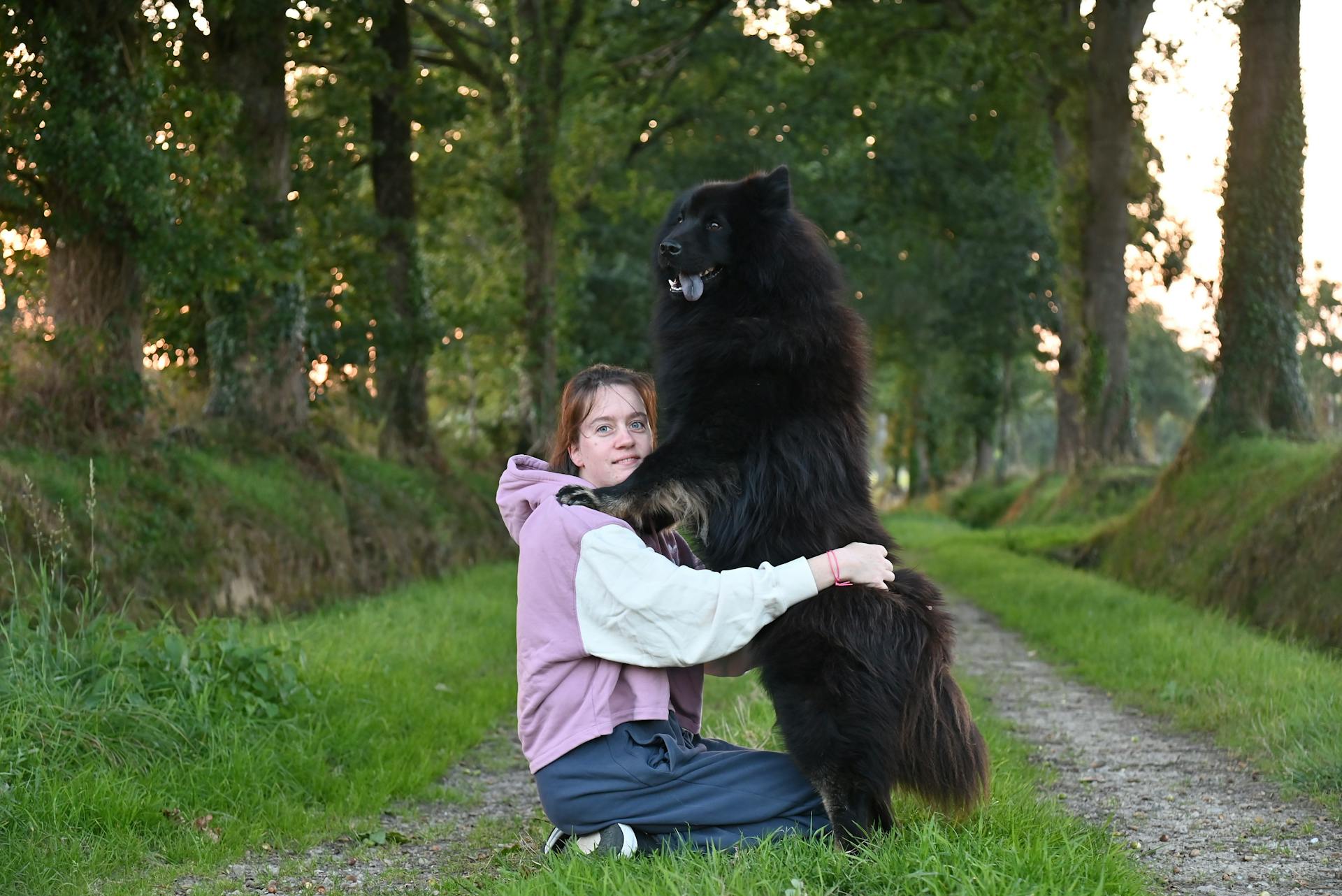
The Irish Wolfhound's comeback was a remarkable story. In 1922, the first official breeding program took place when three pairs of hounds were imported from Germany.
The Kennel Club recognized the breed the following year, calling it “the most beautiful of all sighthounds.” This recognition helped establish the breed's reputation.
The Irish Wolfhound has come a long way since then. Today, more than 100 years later, the breed remains among the world's top ten breeds.
Final Thoughts
As you consider bringing a new furry friend into your family, remember that some breeds require more exercise and space than others. The Irish Wolfhound, for instance, needs a lot of room to run around.
If you're thinking of getting an Irish Wolfhound, make sure to buy from a reputable breeder who can provide you with health clearances for their parents. This can help prevent or mitigate certain health problems that can arise in the breed.
Irish Wolfhounds are indeed gentle giants and make great family pets, but they do need regular exercise to stay happy and healthy.
Frequently Asked Questions
Is an Irish Wolfhound a good family dog?
Yes, Irish Wolfhounds make excellent family dogs due to their loyal and affectionate nature. They thrive on human companionship and enjoy being part of the family.
Is Wolfhound bigger than Great Dane?
While both breeds are massive, Irish Wolfhounds are slightly taller than Great Danes, but Great Danes can weigh significantly more. Great Danes typically weigh 150-160 pounds, making them a sturdy and robust breed.
Are Irish wolfhounds the tallest dog?
Yes, Irish Wolfhounds hold the record for being the tallest dog breed. They stand out for their impressive height and athletic build.
Sources
- https://www.celtictitles.com/blog/irish-wolfhound/
- https://www.akc.org/dog-breeds/irish-wolfhound/
- https://emma.ca/dog-breeds/irish-wolfhound
- https://www.thesprucepets.com/irish-wolfhound-dog-breed-profile-4776801
- https://www.thefarmersdog.com/digest/the-irish-wolfhound-breed-guide-history-personality-grooming-training-health-and-feeding/
Featured Images: pexels.com
